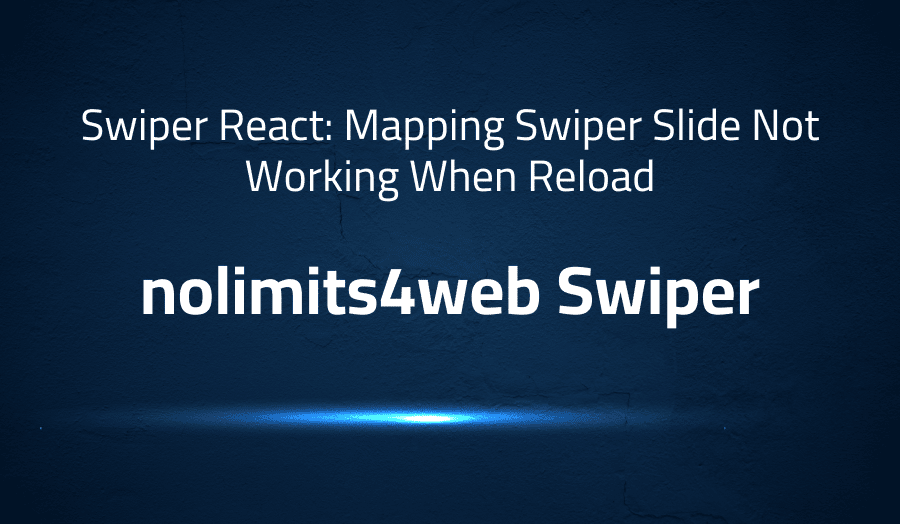

Swiper React: Mapping Swiper Slide Not Working When Reload in nolimits4web Swiper
Explanation of the problem
This issue is related to the behavior of the Swiper component in a React application. The component is used to create a slider for displaying images and it is imported from the “swiper/react” and “swiper” libraries. The component is not working as expected when it is loaded for the first time. It seems that Swiper is not being initialized and it must be changed to another view on the developer tools in order to work.
The following code shows the implementation of the Swiper component in the React application. The component is defined as a functional component called “HomeSlider” and it uses the useEffect hook to initiate the HomeHeadlineImages function. The function fetches movie data from an API and sets the data as the value of the movies state. The slides for the Swiper component are then created from the first five items in the movies state.
function HomeSlider(){
SwiperCore.use([Navigation, Pagination, EffectCoverflow]);
useEffect(() => {
HomeHeadlineImages();
}, []);
const [movies, setMovies] = useState([]);
const HomeHeadlineImages = async () => {
const weeklyMovies = await `fetch('https://api.themoviedb.org/3/trending/movie/week?api_key=xxxxxxx');`
const weeklyRecommendation = await weeklyMovies.json();
setMovies(weeklyRecommendation.results);
}
const slides = [];
movies.slice(0,5).map(movie => (
slides.push(
<SwiperSlide key={movie.id}>
<img src={`https://image.tmdb.org/t/p/w500/${movie.backdrop_path}`} alt=""/>
</SwiperSlide>
)
));
return (
<div>
<div className="headline-home">
<Swiper id="headline" navigation pagination effect="coverflow">
{slides}
</Swiper>
</div>
</div>
)
}
The current behavior of the Swiper component is that it does not work when it is loaded for the first time. There are no extra properties such as “prev”, “active”, “next”, etc. that are usually present when Swiper works. The component only works when the window is changed, not when it is first loaded.
The expected behavior of the Swiper component is that it should work when it is loaded for the first time, not just when the window is changed.
Troubleshooting with the Lightrun Developer Observability Platform
Getting a sense of what’s actually happening inside a live application is a frustrating experience, one that relies mostly on querying and observing whatever logs were written during development.
Lightrun is a Developer Observability Platform, allowing developers to add telemetry to live applications in real-time, on-demand, and right from the IDE.
- Instantly add logs to, set metrics in, and take snapshots of live applications
- Insights delivered straight to your IDE or CLI
- Works where you do: dev, QA, staging, CI/CD, and production
Start for free today
Problem solution for Swiper React: Mapping Swiper Slide Not Working When Reload in nolimits4web Swiper
This issue is related to the nolimits4web Swiper library in the React environment. The issue is that when the code is loaded for the first time, the Swiper component does not seem to initialize. The problem can be resolved by changing the view in the developer tools.
The root cause of the issue is most likely related to the use of the useEffect hook. The useEffect hook is used to run a function HomeHeadlineImages when the component is first loaded. This function retrieves movie data from an API and sets it in the component’s state.
However, it seems that the Swiper component is being rendered before the useEffect hook has finished running and setting the state. To resolve this issue, one solution would be to wrap the return statement of the HomeSlider component in a conditional that only returns the component when the state has been set. Another solution could be to use the useLayoutEffect hook instead of useEffect to ensure that the state is set before the component is rendered.
Other popular problems with nolimits4web Swiper
Problem: Initialization Issue
One common issue with nolimits4web Swiper is that the component may not initialize properly, leading to unexpected behavior. This can occur when the component is rendered before the required data is available or when the Swiper library is not imported correctly.
Solution:
To resolve this issue, it is important to ensure that the Swiper library is imported correctly and that the component is only rendered when the required data is available. This can be achieved by using a conditional statement that only renders the component when the data has been loaded, or by using the useEffect hook to wait for the data to be loaded before rendering the component.
Problem: Navigation Problem
Another common issue with nolimits4web Swiper is that the navigation buttons may not work as expected. This can be caused by incorrect implementation of the navigation options or by the presence of conflicting CSS styles.
Solution:
To resolve this issue, it is important to ensure that the navigation options are implemented correctly and that any conflicting CSS styles are removed. This can be achieved by reviewing the code and removing any conflicting styles, or by consulting the Swiper documentation for correct implementation of the navigation options.
Problem: Performance Issues
Performance issues are a common problem with nolimits4web Swiper, particularly when large amounts of data are being displayed. This can result in slow loading times and a negative user experience.
Solution:
To resolve this issue, it is important to optimize the data that is being displayed and to ensure that the component is optimized for performance. This can be achieved by reducing the amount of data being displayed, by using lazy loading, or by using virtualization to only render the data that is currently visible on the screen. Additionally, it may be necessary to optimize the component’s code to ensure that it runs efficiently.
A brief introduction to nolimits4web Swiper
nolimits4web Swiper is a popular and feature-rich JavaScript library for creating touch-enabled slider and carousel components for modern web applications. It is built using native HTML, CSS, and JavaScript, and does not require any external dependencies. The library has a flexible and modular architecture that allows for customizing and extending the core functionality to meet specific needs.
Swiper supports various touch gestures and mouse events, including swipe, drag, and click, which makes it highly responsive and user-friendly. It provides a range of customization options, including slides per view, looping, pagination, navigation buttons, scrollbar, autoplay, and more. Additionally, the library is optimized for performance and has been tested on a variety of devices and browsers, ensuring a smooth and consistent experience for end-users. Swiper can be easily integrated into any web project and is compatible with popular frameworks such as React, Angular, and Vue.
Most popular use cases for nolimits4web Swiper
- Nolimits4web Swiper is a mobile-first, touch-enabled JavaScript library that can be used for creating flexible, responsive, and touch-friendly slideshows and carousels.
- It allows developers to implement various customization options, such as navigation buttons, pagination, loop mode, autoplay, and mousewheel control, among others. This provides a rich user experience for users and a high level of control for developers.
- Nolimits4web Swiper integrates seamlessly with a wide range of web technologies and frameworks, including Angular, React, Vue, and more. A code block demonstrating its usage in a simple HTML page might look like this:
<div class="swiper-container">
<div class="swiper-wrapper">
<div class="swiper-slide">Slide 1</div>
<div class="swiper-slide">Slide 2</div>
<div class="swiper-slide">Slide 3</div>
</div>
<!-- Add Pagination -->
<div class="swiper-pagination"></div>
<!-- Add Arrows -->
<div class="swiper-button-next"></div>
<div class="swiper-button-prev"></div>
</div>
<script>
var swiper = new Swiper('.swiper-container', {
pagination: {
el: '.swiper-pagination',
},
navigation: {
nextEl: '.swiper-button-next',
prevEl: '.swiper-button-prev',
},
});
</script>
It’s Really not that Complicated.
You can actually understand what’s going on inside your live applications.




